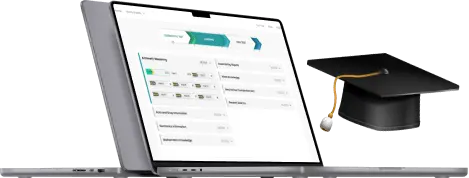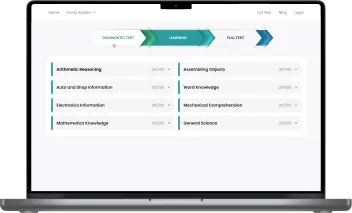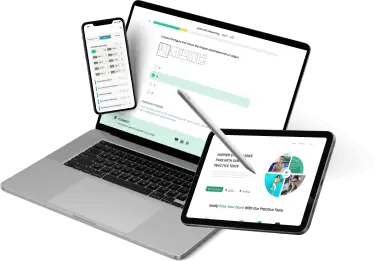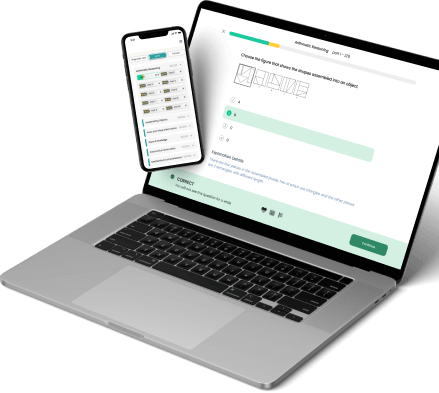Fun & effective VTNE practice test tool to pass with flying colors
All-in-one platform with everything you need to ace the VTNE on your first attempt
Clear and Thorough Learning Path
Proven VTNE 3-step Practice Formula
After our 100,000+ users' success stories, we developed a 3-step strategy to provide you with the most precise and in-depth learning path while minimizing your prep time.VTNE Diagnostic Test
First, take this short test and get your detailed report showing your strong and weak areas. Save your time by concentrating on what is in demand.Learning
With quick, bite-sized learning techniques and a detailed study guide for each VTNE section, you can really strengthen your weaknesses (from step 1) and boost your scores.VTNE Full Test
The last step for your preparation is taking our full VTNE practice tests and seeing how far you've come since the beginning. Repeat the 3-step formula until you are satisfied with your results!Ready to start?
Thousands of VTNE users already accomplished their goals.NOW it’s your turn!

What You Get

All-in-one platform
A complete VTNE Prep Platform, including a diagnostic test, detailed study guides for all topics, practice questions with step-by-step explanations, and various full simulator tests.
Questions nearly identical to those in the real VTNE test
All questions are categorized into the specific sections as on the real VTNE: Same format & same difficulty!
Best for the busy
Easily & quickly grasp all the knowledge with our unique learning technique. And you can learn anytime, anywhere on any devices, even with a few free minutes.
Practice while having fun
Learn and play! Complete round-by-round to reach your daily achievement and make progress on your learning journey!Featured on















What our users are saying
Over 50,000 aspiring American candidates use VTNE monthlyVTNE Test Comprehensive Guide [2024 Updated]
Congratulations if you've just finished a veterinary technology program or are about done. The bulk of your hard work is done, but you still have to pass the Veterinary Technician National Exam (VTNE) before you can begin your job as a licensed, certified, or registered veterinary technician.
There is a ton of advice about how to study for the VTNE available online, as well as companies that sell study materials specifically for the exam that promise to help you pass. With so much information available, it can be challenging to determine which resources are worthwhile for your time and money. Our guide highlights the general information about VTNE.
What is VTNE Exam?
As an entry-level Vet Tech, you must be licensed to practice commercially in order to sit for the VTNE, which measures your level of knowledge and ability. Each year in January and June, the test is given. As a result, the exam is the most competent testing instrument for evaluating applicants for licensing since it is regularly updated and evaluated.
The Veterinary Information Verifying Agency (VIVA), which was formed by the American Association of Veterinary State Boards (AAVSB), is responsible for the development of the Veterinary Technician National Exam (VTNE). You may get more information on the VTNE exam from the AAVSB, which is the organization in charge of administering the test.
Depending on your state or province, you may be required to present an official transcript from your approved institution, which must contain your degree name and the date you graduated. Professional Examination Service will send you an Authorization To Exam (ATT) via email after your application to take the VTNE test has been accepted (ProExam).
VTNE Exam Domains
The test covers nine areas in total:
Pharmacy and Pharmacology
- Your understanding of how to prepare, administer, and dispense pharmacological drugs as well as how these agents impact the anatomy, physiology, and pathophysiology of patients
- Your capacity to inform the customer on the safe use of pharmacological drugs, their effects, and how to deliver them to patients.
Surgical Nursing
- Your understanding of how pathophysiology, anatomy, and physiology relate to surgical nursing.
- Assembling and maintaining the tools and materials the vet will need to carry out the operation.
- The patient's preparation for surgery.
- Operating as both a non-sterile medical technician (protecting the health and appropriate procedure) and a sterile surgical technician (aseptic technique, manipulating tools).
Dentistry
- Your understanding of how anatomy, physiology, and pathophysiology relate to dentistry
- Assembling and maintaining the tools and equipment the veterinarian needs to carry out a dental operation.
- Performing dental procedures, comprising preventative, radiography, rehabilitative, and documenting, as well as providing assistance.
- Educate your customer about the oral health of your patient and aftercare.
Laboratory Techniques
- Using laboratory strategies that can be applied to your understanding of anatomy, physiology, and pathology.
- Gathering, chopping, and keeping samples for examination in the lab
- Performing laboratory tests such as parasitology, microbiology, serology, cytology, hematology, and urinalysis.
- Maintaining the supplies and equipment in the lab.
Animal Care and Nursing
- Applying your understanding of anatomy, physiology, and pathophysiology to the nursing and care of animals.
- Recording patient assessments on their environmental, dietary, behavioral, and physical conditions.
- Performing patient restraint and providing post-operative care, catheterization, wound care, bandaging, and therapy for rehabilitation.
- Performing clinical diagnostic procedures such as electrocardiograms, oxygen saturation, and vital signs.
- Educating your customer about zoonosis, nutrition, pre-and post-operative care, and animal behavior.
- Offering your patients a clean, pleasant, and stable environment.
- Maintaining testing tools and supplies to guarantee accuracy and patient security.
Diagnostic Imaging
- Using your understanding of diagnostic imaging and anatomy, physiology, and pathology.
- Creating patient diagnostic photographs.
- Maintaining diagnostic tools to guarantee accurate test outcomes and patient security.
Anesthesia
- Your understanding of pathophysiology, anatomy, and physiology was applied to the anesthetic.
- Assist in creating a strategy for your patient's anesthesia that is both safe and effective. Develop an anesthetic strategy for medical, pharmacological, and diagnostic treatments.
- Assembling and keeping up the tools required for a secure technique.
- Inform your customer about the use of anesthetics and reassure them that the patient will be safe during the process.
Emergency Medicine/Critical Care
- How emergency medicine and internal medicine use anatomy, physiology, and pathophysiology expertise.
- Perform triage and record the patient's critical condition, encompassing distress, acute sickness, severe trauma, and poisoning. Also, note the patient's physical, neurological, physiological, and environmental conditions.
- Execute critical care and emergency nursing techniques, such as cardiopulmonary resuscitation (CPCR).
- Stopping acute blood loss, stabilizing fractures, and providing continuing oxygen treatment in addition to blood transfusions and fluid resuscitation.
Pain Management/Analgesia
- The application of your understanding of anatomy, physiology, and pathophysiology to pain relief and analgesia.
- For the patient's recovery, determine the necessity for and carry out a pain management strategy.
- Inform your client about how analgesics are administered, pain management techniques, and adverse effects.
VTNE Format
Time
The VTNE test lasts for 3 hours and it is a computer-based exam.
Number of questions
VTNE exam includes170 multiple-choice questions; your score is based on 150 operational questions. The remaining twenty questions are what are known as pilot questions, and their only purpose is to assist in the development of future examinations. Kindly take notice that your responses to these twenty test questions will not be included in your overall score.
Scoring
Your score will be published on a scale ranging from 200 to 800, with a passing score of 425; you will get an official printed score report as soon as the test is complete. In addition to being made accessible to the relevant province or state agency, score reports will also be displayed on your MyAAVSB site roughly two to three weeks after the test session has closed.
Please be aware that by making a request to the VIVA Program, you have the ability to transfer your score to a jurisdiction that is different from the one you started on your application. A charge of $85 will be assessed for the transfer of your veterinarian online score.
Withdrawing
Applicants who withdraw their applications will be eligible for a prorated refund, provided that they do so before the application and refund deadline. After the deadline for refunds, we will only provide partial refunds in the event of an emergency, such as a death in the immediate family or a medical emergency that directly affects you.
Language
Both English and French are acceptable languages for taking the VTNE exam.
Who Is Eligible to Take the VTNE?
There are several states, provinces, and territories that do not have qualifying conditions for the VTNE because they have not created them. The majority of institutions that do impose eligibility restrictions, on the other hand, demand that students provide an official transcript demonstrating that they have successfully completed a veterinary technology program that is accredited in either the United States or Canada.
On-the-job training programs in certain states, such as Alaska, Washington, California, and Wisconsin, provide an alternate route to eligibility that may be utilized in place of university qualifications. These states are among those that offer this alternative route.
Scheduling the VTNE Exam
Each year, the American Association of Veterinary State Boards has designated three different times for candidates to take the Veterinary Technician National Exam (VTNE):
- March 15 to April 15
- July 15 to August 15
- November 15 to December 15
The 15th day of the month immediately before the first month in the exam windows is the cutoff date for submission of applications using the online system. For instance, the application deadline for the testing session that runs from March 15 to April 15 is on February 15. Even early submission is required for requests to retake examinations and for special accommodations:
- The beginning of the year serves as the cutoff date for the first test window.
- The first of May is the cutoff date for submitting these requests for the second testing session.
- The third test window will close on September 1, and the deadline for it is that day.
If a student has already taken the exam more than five times, or if they are testing in Oklahoma, Georgia, Tennessee, Missouri, or Indiana, or if they are testing in Canada, then they are required to request permission to retake the exam. However, this only applies if the student has already taken the exam more than five times.
VTNE Costs and Refund Policies
When a student registers online to sit at the VTNE, they will be required to pay a cost of $310 that uses a major credit or debit card at the time of registration. In most cases, students who are unable to show appropriate identification or who come late to the exam site are not entitled to fee refunds.
In addition, there is a tight time restriction that must be adhered to in order to obtain a refund prior to the day of the exam. In most cases, test takers who skip one date are required to be registered and pay for another day; rescheduling test dates is only feasible within the testing window that was originally specified for the missed date.
Required State Licensure Requirement
Whereas the VTNE cannot stand alone as a certification, several states need it as a component of the licensing procedure for veterinary technicians. Vet technicians may arrange to have their exam results transferred to the state where they want to work, making it simpler for them to meet the requirements for veterinary technician licensure.
For licensing in a new state, some states require veterinary technicians to retake the VTNE, while others accept results from tests taken years or decades earlier. The most efficient and effective approach to learning the criteria for licensing in a certain state or province is to get in touch with the state veterinary board overseeing the region in which the student desires to practice.
Getting your vet tech license might open up more job prospects and lead to chances for more involvement in the veterinary sector. Recent graduates may experience greater job success by using the proof that the VTNE can offer to establish their knowledge and expertise in this sector.
What Happens After the VTNE Exam?
Graduates from accredited institutions of higher learning must get their state licensure before they may put any of the academic coursework they completed while enrolled in a formal veterinary technology program into practice. Passing the NVTE is the standard performance assessment for awarding the majority of individual state licenses.
A license designating the holder as a professional Registered Veterinary Technician, Certified Veterinary Technician or Licensed Veterinary Technician is issued by the state's Board of Veterinary Examiners upon successful completion of the required exams.
How Do I Proceed?
Newly minted technicians often search for positions at vet clinics, institutions, or offices in order to complete any outstanding intern obligations. Specialists who see this as a lifetime job, however, are aware of the need to constantly work on enhancing their performance and honing their practical abilities.
In order to get well-rounded expertise, many recently graduated vet engineers are advised to search for their first employment positions where they may execute what they learned. The stresses and obligations any veterinary technician experiences at work every day are considerably different from those in a clinical context. Nothing can ever compare to real-world, hands-on exposure where professionals may gather as much knowledge as they can.
Training Continues
On-the-job coaching will be an emphasis of job in practically every environment that the recently graduated vet tech will encounter. You may anticipate daily instruction under the direction of qualified veterinarians. Regardless of the environment, technicians will learn how to get acquainted with all the many parts of the profession, such as the medical equipment, and the real daily routines that are typical while working in the veterinary care area.
Real World Procedure
Many freshly graduated students who enter the workforce discover that the many duties they learned in a classroom setting and what they are required to carry out on a regular basis in the actual world vary. When it comes to how they want work to be completed in their practice, every veterinarian will have their own personality qualities.
Exam Is Just The Start
Do not think for a second that passing the national test will launch your career as a veterinary technician. They should just be the start of a profession that includes more than just a lifetime love of what you do.
What to Expect in the VTNE Exam?
Participants in the VTNE are required to report to the testing center at least thirty minutes before the start of the examination. Students who are unable to provide an acceptable form of identification will most likely be denied access to the examination; alternatively, they will be required to pay an additional fee in order to schedule a second sitting for the VTNE.
An online calculator will be accessible to those who are taking the examination. Typically, a dry-erase board, pen, and eraser are also provided for use in doing extra analytical tasks and mathematical computations. These items may be used to aid in the management of additional analytical responsibilities.
The exam has a stringent time limit of three hours; test-takers are permitted to take breaks whenever they feel it is necessary, but the time spent on breaks is subtracted from the total amount of time allowed for the VTNE, which is also three hours.
Practicing for the VTNE
Both the American Association of Veterinary State Boards and a range of other tutoring and educational websites provide a selection of online practice examinations to their users. Candidates pursuing a state-level veterinary technician license may benefit from taking these examinations since it gives them a clear sense of what to expect on the official exam and may enhance their confidence in taking the test.
Because these tests are administered on computers, the online sample tests may provide students with a realistic idea of what to expect from the actual exam. It is also essential that providing answers that are inaccurate will not get you in trouble. As a result, it is advantageous for the student to venture an informed estimate in response to queries for which they are unsure of the answer.
Our VTNE Application features
- Free Practice Questions: 1000+ FREE VTNE practice questions with detailed explanations are available for all of the required skills. All you need to pass your recruitment test is available here.
- VTNE Practice Tests Based On Real Tests: Same number of questions, same time limits, same structure. The exam simulators let you familiarize yourself with the test format and get totally ready for the real one.
- No Sign-Up Or Login Required: All of your progress is saved without an account, even if you close your browser. But login can sync your data between web and mobile applications.
- Gamification: The learning process will be divided into small milestones. Let’s make your studying exciting as if you were in some interesting games.
- Personal Study Plan: Just enter your VTNE test date, and a study plan will be set up for you. A clear schedule will surely exceed your expectation and get you the best preparation for the reading shot.
- 3 Interesting Test Modes: 3 different test modes with increased difficulty levels let you experience the VTNE practice test in various ways.
- Dark Mode: Experience a dark theme that is more friendly to your eyes, and get a whole new and marvelous experience.
- No Internet Required: Study on the go conveniently without any Internet connection.
- VTNE Test Bank: 3 features: Weak/ Medium/ Strong questions help you clearly determine which area you should pay more attention.
VTNE Exam FAQs
How do I become VTNE certified?
In order to become VTNE-certified, you will first need to finish authorized coursework, such as a veterinary technician preparation program. Typically, this might take anywhere from one to 2 years to finish. Students are eligible to receive the VTNE after they have received their diplomas.
How to sign up for the VTNE exam?
You will first need to determine whether or not you are qualified to take the VTNE examination before you can register for the test. After it has been determined that you are eligible for the program, you will be able to submit your application via the AAVSB website. After your application has been reviewed and accepted, you will be able to choose a time and place for the examination.
What is the percentage of students that pass the VTNE?
The passing rate for the VTNE has been consistently high over the last 3 years, averaging 76%. The data from March 2014 through February 2017 was used to calculate this percentage.
What is the minimum score required to pass the VTNE exam?
The minimum score required to pass the VTNE fluctuates from one state to the next. The VTNE is rated on a scale that may vary anywhere from 200 to 800, with 425 being the minimum required score to pass in certain states. The VTNE is evaluated on a scale ranging from 0 to 100, and the minimum score required to pass the exam in other states is set at 90.
Who is eligible to take the VTNE exam?
The majority of states and all jurisdictions will classify veterinarians according to whether or not they graduated from a veterinary school that was approved by the American Medical Association or the Canadian Medical Association. On the other hand, under some circumstances and in three of the United States' states, alternative education or credentials are permitted.
Particularly demanding are the On-the-Job Training (OJT) or alternative degree requirements imposed by the states of Alaska, California, and Wisconsin. Get in touch with the appropriate state agency for further information.
Can I take the test more than once?
A candidate may take the VTNE up to 5 times before being disqualified (since January 1, 2006). If you want to take the test after the fifth time you've already taken it, you have to get the consent of the AAVSB Board of Directors beforehand.
The Bottom Line
For people who like dealing with animals, being a veterinary technician may provide both obstacles and pleasures. Aspiring veterinary technicians may greatly increase their chances of success by obtaining the appropriate educational background and credentials. The VTNE may be a crucial element in the development of becoming a certified vet tech. We hope that the above article can be beneficial for you during the process of preparing and acing this exam.






